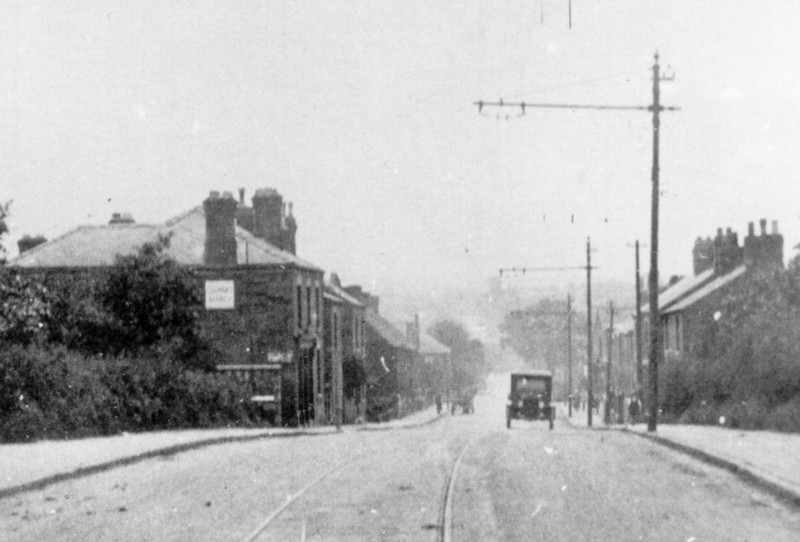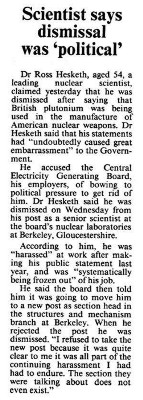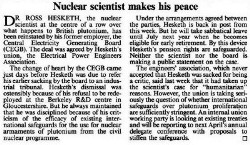Ross Hesketh
(Whistle-Blower)
This page tells the story of a Grocers son from Codnor who went on to become a leading nuclear scientist responsible for exposing the covert supply of Plutonium from the UK's Magnox reactors for use by the US Military.
A subject that had been previously denied by both the Thatcher and Reagan Governments.
Fig.1 This image from the late 1920s shows Hesketh's Grocers shop at the top of Heanor Road on the left. It still exists and is now a Tanning salon.
Ross Vernon Hesketh was born in Codnor on 5th April 1929, where his parents kept a grocery shop at the top of Heanor Rd. He attended Heanor Grammar School and went on to study physics at King's College, Durham University, where he was awarded his PhD in 1954. He spent a year as a Base Leader for the Falkland Islands Dependency Survey (the future British Antarctic Survey) in 1955-56.
On his return to England he took up three years of post-doctoral research at Glasgow University, when he married Elva Turner, whom he had met at King's in 1952. He was then offered a job by the Central Electricity Generating Board (CEGB) at their research laboratories at Berkeley, in Gloucestershire.
He first worked at the Dounreay nuclear establishment in Caithness, at which research was being conducted into the fast breeder reactor, but then went to the CEGB’s Research Laboratories at Berkeley, Gloucester. Between 1964 and 1966 he was the Research Head, Radiation Damage and between 1966 and 1983 the Research Head, Solid State Physics.
During the Cold war the US military had increased its arsenal of nuclear weapons from 3000 in 1955 to 31000 in 1965. Establishing this increase required large amounts of Plutonium some 130 tons in fact. Not surprisingly there was a shortage of Plutonium in the USA.
President Reagan’s administration in the1980’s still had around 23000 nuclear weapons and Hesketh suspected that plutonium from British civil nuclear-power Magnox reactors was being supplied to the USA for use in nuclear weapons.
He questioned the ethics of using this type of Plutonium for Military purposes but the CEGB denied any such trade was taking place.
More importantly the British and American Governments were promoting the Non-Proliferation Treaty that aimed to separate civil and military nuclear activities. Both industry and government decided that it would deny any such links. A number of "categorical assurances" were given by Margeret Thatchers Conservative government to Parliament in February 1983 that "No plutonium produced in the UK civil reactors has ever been consigned for defence use or exported for defence use."
Frustrated with the CEGB and the British Governments stance, Ross wrote a letter to the Times newspaper, which was published on 30th October 1981.
It reads as follows
"As a member of the civil nuclear energy programme of the United Kingdom I have for several years assured my critics that civil nuclear energy is distinct from military nuclear energy ... if at this juncture the UK were to sell plutonium to the Reagan administration, I do not rationally think it could be maintained that we, the UK, have distinguished civil use from military use."
This was a huge embarrassment for the Government and the CEGB who were furious because the letter had been deliberatly written on CEGB letter headed paper.
Ross was offered alternative positions within the organisation, when he refused he was sacked.
Displayed with kind permission
of Harold Beck
www.haroldbeck.org.uk
He submitted another article to the “Times” in June 1983 making his feelings about his dismissal quiet clear.
Ross felt he had been unfairly dismissed and promised to refer his case to an Industrial Tribunal.
With just days to spare, the CEGB had a miraculous change of heart as the article below from the "New Scientist" dated 3rd November 1983 explains.
Image credited to The New Scientist
However Ross was not finished. He became involved in the 1983-84 Inquiry into the first UK Pressurised Water Reactor at Sizewell. This provided an opportunity to prise information from the Government and the nuclear industry. As a member of the Campaign for Nuclear Disarmament Sizewell Working Group, Hesketh uncovered details of the plutonium accountancy procedures at Sellafield then operated by British Nuclear Fuels Ltd (BNFL).
Ross Hesketh and the group's efforts established beyond doubt that the Magnox reprocessing line at Sellafield co-processed low-burn-up plutonium from the civil and military reactors at the same time.
The group obtained an admission from BNFL that their phrase "military plutonium", used at the inquiry, did not describe its origin in a military reactor but rather its end use in a nuclear warhead.
Ross's revelations won recognition in his award by the California-based Project Censored of 1984's "Most Censored Foreign Story", on the Myth Of The Peaceful Atom.
When the "categorical assurances" were next addressed in Parliament in 1986, they had changed very significantly. Margaret Thatcher, the then Prime Minister, repeated the statement that civil plutonium had not gone into weapons, but added the important qualification "during the period of the current administration".
Though this was an admission that Hesketh was correct, government and the nuclear industry had clearly decided that the new line was as far as they were prepared to go. Subsequent attempts to get the Government to clarify their change of tack, for example by CND at the Hinkley Point C Inquiry in 1988-89, were unsuccessful.
In the mid-1980s Hesketh survived by becoming a teacher. From 1985 to 1988 he was Professor of Physics at Bayero University in the northern Nigerian city of Kano. For four years he ran the Science Faculty as well as teaching; and was much loved by his Nigerian students. Never ones to take the easy way out, Ross and his wife Elva travelled back from Nigeria across the Sahara by public transport - taxis, local buses and trucks. From 1989 to 1991 he taught at Sultan Qaboos University in Muscat, Oman.
Ross Hesketh’s last scientific project was a textbook entitled A Less Erroneous Kinetic Theory of Gases.
But whilst writing this book he was diagnosed with an incurable tumor and was given only months to live. But he was determined to see his book finished. Ross completed the text, supervised the production of the manuscript at a local print-shop and died two days later on 3rd April 2004 at Lower Stone in Gloustershire.
He is survived by his wife Elva and two sons and two daughters.
Information for this page is credited to the following sources.
The Times: 30th October 1981
The Times: June 1983
New Scientist 3rd November 1983
The Times: 29th April 2004
The Independent, Keith Barnham: 17th April 2004
The Guardian, David Lowry: 29th April 2004



